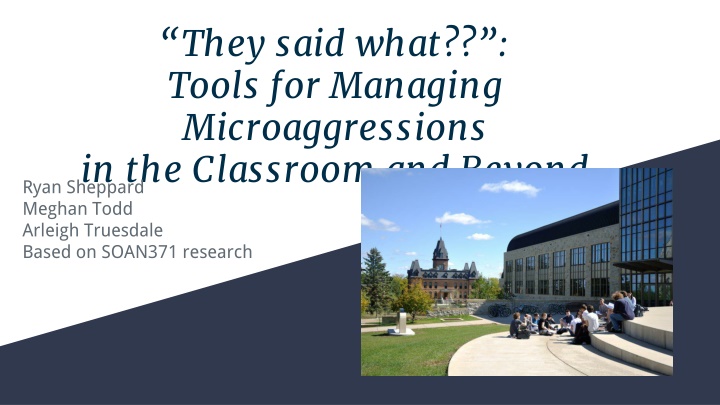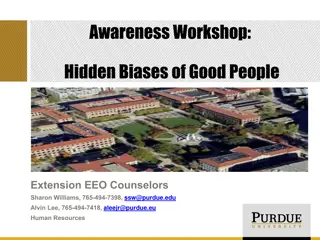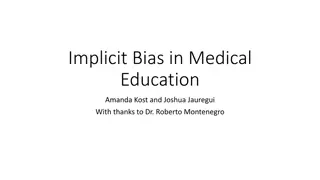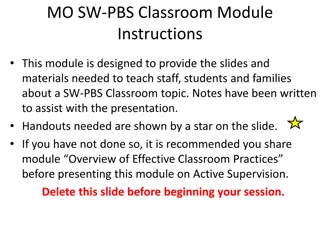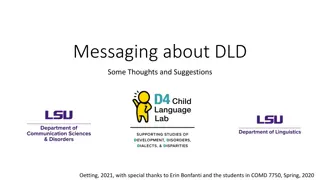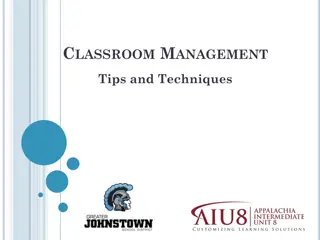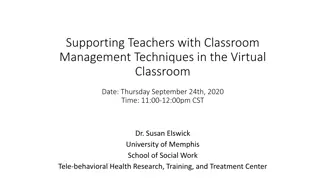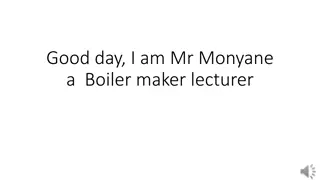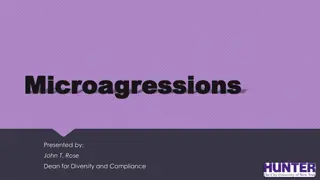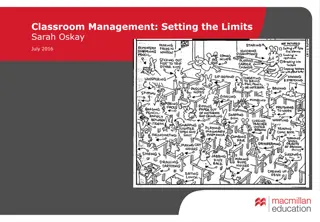Tools for Managing Microaggressions in the Classroom and Beyond
Explore ways to identify and address racial microaggressions in academic settings through scenarios, research insights, and student perspectives. Learn about the different subtypes of microaggressions and why it's important to create an inclusive and supportive environment for all students.
Download Presentation

Please find below an Image/Link to download the presentation.
The content on the website is provided AS IS for your information and personal use only. It may not be sold, licensed, or shared on other websites without obtaining consent from the author.If you encounter any issues during the download, it is possible that the publisher has removed the file from their server.
You are allowed to download the files provided on this website for personal or commercial use, subject to the condition that they are used lawfully. All files are the property of their respective owners.
The content on the website is provided AS IS for your information and personal use only. It may not be sold, licensed, or shared on other websites without obtaining consent from the author.
E N D
Presentation Transcript
They said what??: Tools for Managing Microaggressions in the Classroom and Beyond Ryan Sheppard Meghan Todd Arleigh Truesdale Based on SOAN371 research
Scenarios 1) You have assigned a reading about Muslim Americans along with some study questions. You start class by asking the first study question. No students raise their hands to speak. Many of them look at the one Muslim American student in class. 2) A student group is giving a class presentation and has a photograph of a Native American basketball team (wearing Nike gear) up on the screen. One of the presenting students comments, They look so normal. 3) Just before class starts, you hear one student say to a couple of others quietly, but loud enough for you and others to hear it I know I shouldn t repeat this, but and then proceed to tell a racist joke 4) As part of your course, students present short narratives to the class. When a student presents a narrative about racism and then asks for questions and comments, another student says I didn t sign up to spend class time on this. If we could all just get along, racism would go away.
Overview SOAN371 Research on Microaggressions ( Everyday Racism ) Method and survey questions Student voices Sample Students of Color 3 white women Key points: Want to support ALL students MAs cause harm Professors may be ill-equipped to address MAs This is a start
Why are we talking about this? Student Comments: I feel like I am not important nor is my voice or my thoughts. People of color are less likely to participate in a classroom full of white students. "Microaggressions occur all the time and even when students of color report them, nothing happens, which leads to us feeling like we don't belong on this campus
What are Racial Microaggressions (MAs)? Racial insults in the form of verbal, behavioral, or environmental indignities (Minikel-Lacocque 2013:435) Intentional/not, conscious/not, overt/covert Subtle, often ambiguous, yet ubiquitous Problematic term Term coined by psychiatrist/professor Chester Pierce in the early 1970s to describe modern-day racism in the U.S. 4 subtypes, per Sue et al. (2007) and Minikel-Lacocque (2013)
Subtypes of Racial Microaggressions Microinsults: Verbal/nonverbal actions that convey negative assumptions about, disregard, or belittle minoritized groups; often unconscious and unintentional Microinvalidations: Verbal actions that ignore, neutralize, negate, or dismiss the experiences and emotional realities of racially, ethnically, and nationally marginalized people; often unconscious Microassaults: Small-scale attacks or disparagements using demeaning/ degrading actions/words; often conscious and intended to harm the target Environmental Microaggressions: MAs that manifest at a systemic/ macroscopic level, such as curricular exclusion/marginalization of voices of color; often hard to recognize and remedy
Racial MAs experienced/observed in St. Olaf classrooms, Fall 2017 (first 11 weeks) Student- to-student Professor- to-student MICROINSULTS (REN=race/ethnicity/nationality) Stated or implied a REN stereotype that targeted a student in the class Stated or implied a REN stereotype about a group Focused uninvited attention on a student of color or an international student Belittled or made fun of someone s REN background 33.3% 59.9% 39.2% 20.4% 15.2% 27.9% 35.5% 5.7% MICROINVALIDATIONS Minimized a student s comments/contributions because of their REN Stated or implied I don t see color regarding race and ethnicity Stated or implied that racism doesn t exist anymore Appeared to assume a student has high or low intelligence based on their REN 32.0% 36.0% 23.1% 25.6% 11.3% 11.4% 7.8% 9.3% MICROASSAULTS Told a joke that mocked or degraded a REN group(s) Mocked language styles or imitated accents Used a racial slur to address or refer to person of color 39.7% 42.8% 14.1% 10.3% 8.7% 3.0%
Racial Differences in Reporting Students of color reported higher rates of classroom MAs than did white students. MAs Reported by in St. Olaf Classrooms in Fall 2017 classes (11 weeks) Students of Color 46.1% 47.7% 21.9% 13.2% 13.2% 5.4% White students 37.2% 39.6% 10.0%** 7.0%* 8.5% 1.7%* Student told a joke that mocked or degraded a REN group(s) Student mocked language styles or imitated accents Student used a racial slur to address or refer to person of color Professor told a joke that mocked or degraded a REN group(s) Professor mocked language styles or imitated accents Professor used a racial slur to address or refer to person of color *=p<.05; **=p<.01
How do MAs harm students, according to the scholarly literature on racial MAs? 1. Students of color in predominantly white classrooms often feel scrutinized and stereotyped (Harwood 2015, Harper 2013). 2. Racial microaggressions can cause physical avoidance and emotional withdrawal, inflicting racial battle fatigue on students of color (Smith et al. 2007). 3. Students may disengage from or drop a class (Harwood 2015). 4. Assumptions of racialized intelligence raise additional barriers to academic experiences of students of color (Minikel-Lacoqcue 2013). *Much focus is on the cumulative effects of MAs.
Research on MA harms at St. Olaf (fall 2017) Among students who reported being targeted by and/or observing one or more racial MAs in a class, 86.5% reported negative psychological, social, and/or academic impacts 73.2% of students reported negative impact on psycho-emotional well-being Higher stress level Lower sense of belonging Lower self-esteem 64.2% of targets reported negative impact on relationships with professors and peers Lower support for contributions in class Lower desire to socialize after class Lower inclusion in small groups and group work Lower comfort asking professor for help 65.4% of targets and observers reported negative impacts on academics Lower ability to focus in class Lower motivation to study Lower interest in participating Lower interest in continuing to take the class
Examples of student comments There s a feeling of hopelessness, especially with professors who are on tenure, when you hear microaggressions from them and know that they'll never get in trouble for it/they'll get to keep perpetrating racism in the classroom for years to come. "I worked as a tutor through the ASC [with a student of color]. The professor of the class acted in an extremely racist and biased way. The professor didn't believe that the student was intelligent enough to understand the course material [and] assumed that because [this] was a student of color from a poor neighborhood, the student would never be able to keep up with the coursework or the expectations at St. Olaf. By the end of the semester the professor had given up on the student, and the student ended up dropping the class. The student has since left St. Olaf.
And yet I believe most people are adult enough to shrug off impolite or insensitive statements that are made accidentally, or are unintentional. This focus on microaggressions and sensitivity is hurting the community at large and pandering to ideologies and zealots. I think this [survey] is making a huge fuss out of inconsequential issues. It would be best for the school to quietly abandon [the diversity push]
Responses to MAs during class Some key points from the scholarly literature on MAs: Learn to recognize MAs. Don t ignore MAs. Address MAs in varied ways, depending on the circumstances. * Be respectful. Ask questions. * Confront students who use stereotypes less likely in the future Check in with targets. (Don t assume how they feel or what they want.) Provide and/or co-create guidelines for students: If this happens in class, here are some things you can do
Perceptions of effectiveness vs. reported responses Student perceptions of the MOST AND LEAST EFFECTIVE responses to MAs Most effective Confront enactor gently, ask questions: 62.3% Least effective Confront the enactor forcefully/yell: 49.5% Talk with enactor later, privately: 27.5% Stay silent or ignore the incident: 48.5% Call out enactor right away: 17.3% Leave the room: 2.6% Most commonly reported ACTUAL responses to MAs by students and professors Student responses Nonverbal response: 64.7% Professor responses Ignored, stayed silent, changed subject: 36.1% Did not notice the MA: 27.8% Froze and stayed silent: 47.1% Contacted another student from class later: 45.3% Confronted the enactor gently: 16.5%
Examples of student comments The onus needs to be on the professors to inform their students to call out, and how to call out both them, and fellow students when micro-aggressions occur. Students are often scared to confront authority, but when professors open up the discussion, students might be more likely to speak up. It would be very beneficial to have professors trained on how to de-escalate these situations... I had a professor in the past who didn't address a microaggression [in] the classroom, so instead a student stepped in. I think it might have been more productive if the professor had addressed the problem.
Scenarios 1) You have assigned a reading about Muslim Americans along with some study questions. You start class by asking the first study question. No students raise their hands to speak. Many of them look at the one Muslim American student in class. 2) A student group is giving a class presentation and has a photograph of a Native American basketball team (wearing Nike gear) up on the screen. One of the presenting students comments, They look so normal. 3) Just before class starts, you hear one student say to a couple of others quietly, but loud enough for you and others to hear it I know I shouldn t repeat this, but and then proceed to tell a racist joke. 4) As part of your course, students present short narratives to the class. When a student presents a narrative about racism and then asks for questions and comments, another student says I didn t sign up to spend class time on this. If we could all just get along, racism would go away.
Proactive Responses by Professors Definition: Tools used in advance to prevent and mitigate racial MAs in the classroom
Student views and experiences of proactive actions by professors What are students views of the effectiveness of professor actions to proactively address racial MAs in class? Not at all Effective 10.4% 6.7% 17.3% 15.9% 9.4% Somewhat Effective 52.8% 40.9% 52.4% 46.0% 37.8% Highly Effective 36.8% 52.4% 30.3% 38.1% 52.8% Discussed guidelines for how to address racism in class Initiated discussion of racism regarding class materials Used the term microaggression, as related to the course and its material Initiated discussion of microaggressions in the classroom Initiated discussion of racism in response to campus/societal events In how many of their courses did students experience professors taking these actions to proactively address racial MAs in classes in fall 2017 (first 11 weeks)? 0 1 2 3/+ courses 46.1% 21.4% 53.4% 66.7% 40.9% course 25.4% 34.7% 31.3% 22.7% 32.5% courses 15.2% 24.7% 10.6% 6.3% 17.2% courses 13.3% 19.1% 4.6% 4.4% 9.3% Discussed guidelines for how to address racism in class Initiated discussion of racism regarding class materials Used the term microaggression, as related to the course and its material Initiated discussion of microaggressions in the classroom Initiated discussion of racism in response to campus/societal events
Example of Student Comments The class that I have experienced the most microaggressions in is also the only one that attempts to discuss race and racism. I think that some people accidentally make microaggressions when attempting to talk about some of the issues of race [in] class discussions. I believe that in a safe, supportive, and educational environment, there is somewhat of a necessity to be able to make those mistakes as long as the others in the class and the professor correct them because it is a part of the learning experience and it is important to allow those discussions.
Course materials Culturally relevant pedagogy (Ladson-Billings 1995) which course materials incorporate voices from racially/ethnically marginalized groups This can be transformative for students: increase their cultural competence Increase their critical thinking around issues of race and ethnicity helping students understand structural causes of racial/ethnic inequalities (Nagda et al. 2003; Lopez 1998). Where culturally relevant pedagogy is absent, students of color report feeling marginalized, devalued (Fishman and McCarthy 2006).
Student reports of R/E marginalized voices within course material in majors, etc. To what extent do students report that R/E marginalized voices are included within material in their majors, concentrations, and conversation programs? Most or all of the course materials 10.1% 18.8% 8.7% Many of the course materials Some of the course materials 37.1% 28.2% 34.3% None or almost none of the course materials 32.1% 32.9% 41.3% Major Concentration Conversation Program 20.6% 20.0% 15.7% *Across many departments and divisions (lots of time for improvement)
Your Ideas How can you take proactive approaches in your classes? Think about and discuss one or two specific ideas. **************************** Care to share your ideas?
Conclusion Microaggressions (MAs) in St. Olaf classrooms harm students To promote the well-being and development of ALL students, professors need to: 1. become educated about MAs and racism (Patterson-Rivera 2014) 2. gain training and practice with tools for engaging with and preventing MAs in the classroom (Harwood 2015). Our work today is a start. Where from here? Our/your work + Institutional support Effective MA interventions + Proactive actions Fewer MAs (in and outside class; likely spillover) Reductions in harms to students Increased support for ALL students well-being and development
(Maybe) We have a few more minutes .. Questions? Comments?
